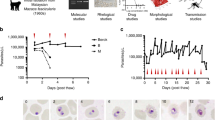Abstract
The ability to culture continuously proliferating cell lines of various organisms in vitro has provided numerous advantages in experimental approaches toward the understanding of basic biology and disease. Although in vitro approaches are common in many disciplines, this methodology has proven difficult to exploit in the study of helminthic parasites. A major cause of parasitic disease, particularly in tropical countries, is the trematode Schistosoma mansoni. We have developed in vitro techniques that allow the long term maintenance of cell cultures from two stages of the life cycle of this organism, associated with its mammalian and the molluscan hosts. We have developed quantitative assays of cell survival and proliferation in our culture systems, and obtained evidence for limited proliferation in vitro. Although the cultures we have achieved thus far are useful for many kinds of experiments in vitro, development of continuously proliferating cell lines remains our goal.
Similar content being viewed by others
References
Barnes D (1987) Serum-free animal cell culture. Biotechnology 5: 534–545.
Basch P (1981) Cultivation of Schistosoma mansoni in vitro: establishment of cultures from cercariae and development until pairing. J Parasitol 67: 179–185.
Bayne CJ (1976) Culture of molluscan organs: a review. in: Invertebrate Tissue Culture, Maramorosch K (ed), Academic Press, pp. 61–74.
Bayne C, Menino J, Hobbs D and Barnes D (1994) In vitro cultivation of cells from larval S. mansoni. J Parasitol 80: 29–35.
Bergwerff A, van Dam G, Rotmans J, Deelder A, Kamerling J and Vliegenthart J (1994) The immunologically reactive part of immunipurified circulating anodic antigen from Schistosoma mansoni is a threonine-linked polysaccharide. J Biol Chem 269: 31510–31517.
Clegg JA (1965) In vitro cultivation of S. mansoni. Exp Parasitol 16: 133–147.
Coles GC and Fitzgerald J (1986) Effect of nutagen on cultured Schistosoma mansoni. J of Helminthology 60: 135–142.
Coles GC and Bruce JI (1987) In vitro selection of drug resistant Schistosoma mansoni. Internat J Parasitol 17: 767–771.
dos Reis M, Davies R, Singh H, Skelly P and Shoemaker C (1993) Characterization of the S. mansoni gene encoding the glycolytic enzyme triosephosphate isomerase. Molec Bio Parasitol 59: 235–242.
Duvaux-Miret O, Stefano GB, Smith EM, Dissous C and Capron A (1992) Immunosuppression in the definitive and intermediate hosts of the human parasite Schistosoma mansoni by release of immunoactive neuropeptides. Proc Natl Acad Sci 89: 778–781.
Hansen EL (1976) A cell line from embryos of Biomphalaria glabrata (Pulmonata): Establishment and characteristics. In: Invertebrate Tissue Culture. Maramorosch K. (ed), Academic Press. p. 75–99.
Harrop R and Wilson RA (1993) Protein synthesis and release by cultured schistosomula of S. mansoni. Parasitology 107: 265–271.
Hobbs D, Fryer S, Duimstra J, Hedstom O, Brodie A, Menino J, Bayne C and Barnes D (1993) Cultures of cells from juvenile worms of Schistosoma mansoni. J Parasitol 79: 913–921.
Iltzsch MH, Bieber D, Vijayasarathy S, Webster P, Zurita M, Ding J and Mansour TE (1992) Cloning and characterization of a cDNA coding for the alpha-subunit of a stimulatory G protein from Schistosoma mansoni. J Biol Chem 267: 14504–14508.
Makaaru CK, Damian RT, Smith DF and Cummings RD (1992) The human blood fluke Schistosoma mansoni synthesizes a novel type of glycosphingolipid. J Biol Chem 267: 2251–2257.
Morris H and Dell A (1995) A unique multifucosylated 3GalNAc-betal-4GlcNAc-Betal-3Gal-alpha-1 motif constitutes the repeating unit of the complex O-glycans derived from the cercarial glycocalyx of Schistosoma mansoni. J Biol Chem 270: 17114–17123.
Mountford A, Harrop R and Wilson R (1995) Antigens derived from lung-stage larvae of Schistosoma mansoni are efficient stimulators of proliferation and gamma interferon secretion by lymphocytes from mice vaccinated with attenuated larvae. Infect and Immun 63: 1980–1986.
Newport GR and Weller TH (1982) Deposition and maturation of eggs of Schistosoma mansoni in vitro: Importance of fatty acids in serum-free media. Am J Trop Med Hyg 31: 349–357.
Pan S CT (1980) The fine structure of the miracidium of Schistosoma mansoni. J Invert Pathol 36: 307–372.
Pearce E and Appleton J (1992) Production of immunomodulatory neuro-peptides by Schistosoma mansoni. Parasitol Today 8: 353.
Rajkovic A, Davis RE, Simonsen JN and Rottman FM (1990) A spliced leader is present on a subset of mRNAs from the human parasite Schistosoma mansoni. Proc Natl Acad Sci 87: 8879–9993.
Shoemaker C, Ramachandran H, Landa A, Dos Reis M and Stein L (1992) Alternate splicing of S. mansoni geni encoding a homologue of epidermal growth factor receptor. Mol Biochem Parasitol 53: 17–32.
Smit A, Vreugdenhil E, Ebberink R, Geraerts W, Klootwijk J and Joosse J (1988) Growth-controlling molluscan neurons produce the precursor of an insulin-related peptide. Nature 331: 535–538.
Solis-Soto J and de Jong-Brink M (1994) Immunocytochemical study on biologically active neurosubstances in daughter sporocysts and cercariae of T. ocellata and S. mansoni. Parasitology 108: 301–311.
Srivatsan J, Smith D and Cummings R (1994) Demonstration of a novel UDPgalNAc beta 1–4 N-acetylgalactosaminyltransferanse in extracts of Schistosoma mansoni. J Parasitol 80: 884–890.
Stibbs H, Oxczarzak A, Bayne C and DeWan P (1979) Schistosoma sporocyst-killing amoebae isolated from Biomphalaria glabrate. J Invert Pathol 33: 159–170.
Weller TH and Wheeldon SK (1982) The cultivation of cells derived from adult Schistosoma mansoni. Am J Trop Med 31: 335–348.
Author information
Authors and Affiliations
Rights and permissions
About this article
Cite this article
Bayne, C.J., Barnes, D.W. Culture of cells from two life stages of Schistosoma mansoni. Cytotechnology 23, 205–210 (1997). https://doi.org/10.1023/A:1007924022900
Issue Date:
DOI: https://doi.org/10.1023/A:1007924022900




